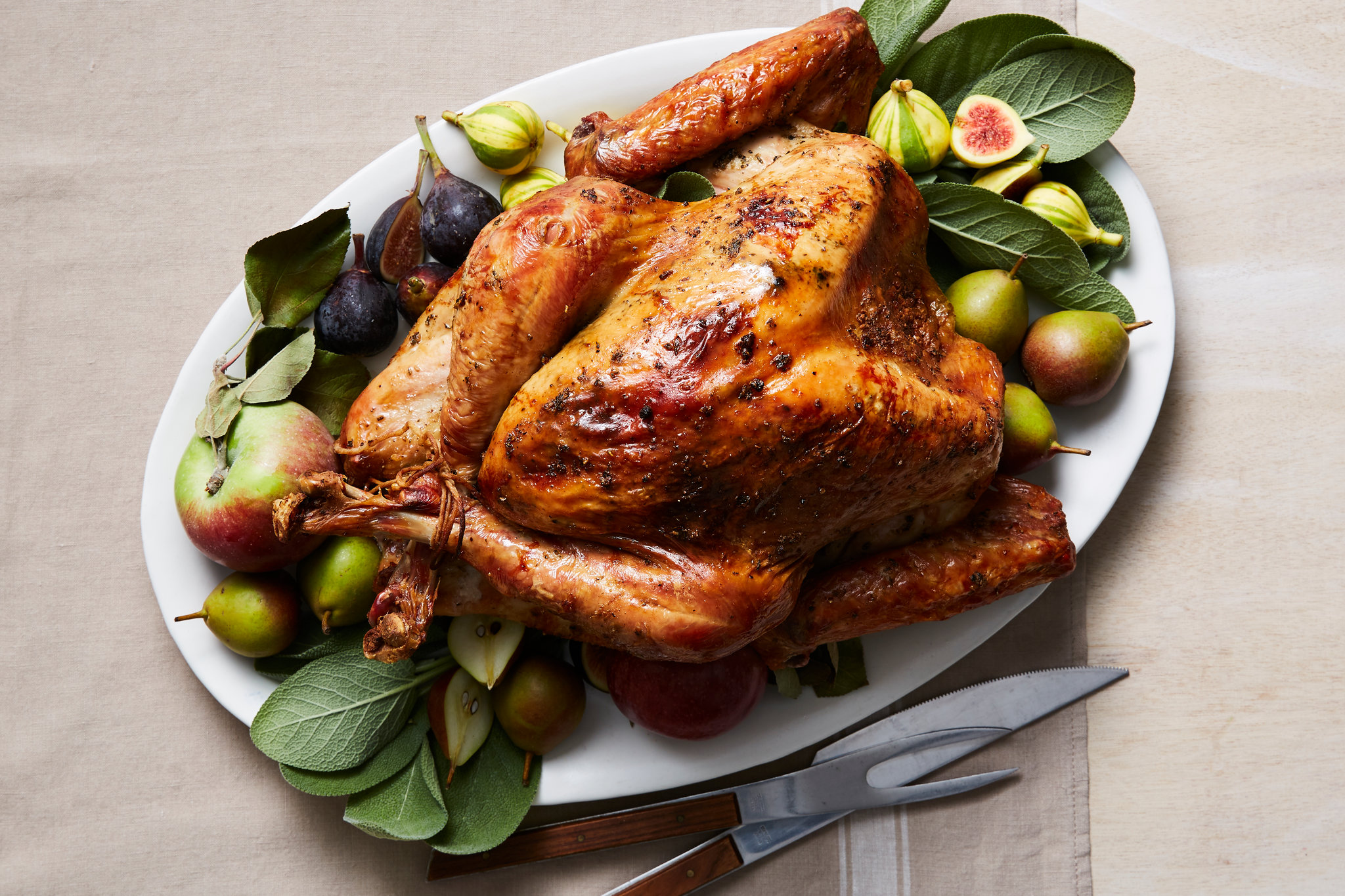Whether you’re cooking your first Thanksgiving meal or are a seasoned holiday host, you’ll discover the intricate dance between the rich flavors and textures of a perfectly cooked turkey, the stuffing filled with hints of sage and rosemary, and the cranberry sauce adding a delightful tangy-sweet note to each bite. From the golden-brown skin that provides a satisfying crunch to the succulent, juicy meat beneath it, every aspect of a turkey meal is a testament to the beauty of food shared with loved ones.

Foodborne illnesses or food poisoning can arise from various sources, and Turkey is no exception. Understanding the safety risks associated with consuming turkey and the measures necessary to ensure it’s cooked and stored correctly is critical to avoiding food poisoning.
Can You Get Food Poisoning From Turkey?
You can get food poisoning from turkey, usually from primary bacterial culprits such as Salmonella, Campylobacter, and Clostridium perfringens. Turkey food poisoning typically occurs when the meal is improperly handled or cooked.
Please read our article How Long Does Food Poisoning Last?
Let us analyze each bacteria:
Salmonella
Salmonella contamination in a turkey meal usually occurs due to improper handling and cooking.
Salmonella Contamination Process
- During Processing: Turkeys may carry Salmonella in their guts. During the processing of the bird, the bacteria can be spread to the meat. If the inside of the turkey comes into contact with feces during slaughter, the risk of contamination increases. The bacteria can then multiply on the meat if improperly handled and cooked.
- Cross-Contamination: Even if the turkey is Salmonella-free, it can be contaminated in the kitchen. This can occur if raw turkey comes into contact with other foods or kitchen surfaces. For instance, cross-contamination can occur if you use the same cutting board and knife to prepare the turkey and different ingredients without washing them.
- Improper Cooking and Storage: Even if a turkey is contaminated with Salmonella, proper cooking can kill the bacteria. The U.S. Department of Agriculture recommends cooking turkey to an internal temperature of 165°F (74°C) to kill Salmonella and other foodborne bacteria. The bacteria can survive and multiply if the turkey isn’t cooked to the recommended temperature or left at room temperature for too long after cooking.
Symptoms of Salmonella Infection
If you consume turkey contaminated with Salmonella, you may develop symptoms of salmonellosis, the infection caused by this bacteria. These symptoms typically appear between 6 hours and six days after consuming the contaminated food, though it’s most common within three days.
The symptoms of a Salmonella infection typically include:
- Diarrhea: This is the most common symptom. Diarrhea may be watery and occasionally may contain blood.
- Fever: A person with a Salmonella infection usually has a fever, often accompanied by chills.
- Abdominal Cramps: Abdominal pain or cramps typically occur, ranging from mild to severe.
- Nausea and Vomiting: Some people may experience nausea and vomiting.
- Headache and Muscle Pains: These are less common but can occur.
Most people recover from Salmonella infection within 4 to 7 days without treatment. However, in some cases, the diarrhea may be so severe that the patient needs to be hospitalized. In rare cases, the Salmonella infection may spread from the intestines to the bloodstream and other body sites, which can be fatal unless the person is treated promptly with antibiotics.
Salmonella is a genus of bacteria that can cause serious illness if ingested. Raw and undercooked turkey may harbor Salmonella. Symptoms of Salmonella poisoning include abdominal cramps, diarrhea, fever, and vomiting, which can begin 6 hours to 6 days after exposure and last for 4 to 7 days.
According to the Centers for Disease Control and Prevention (CDC), Salmonella bacteria cause about 1.35 million infections, 26,500 hospitalizations, and 420 deaths annually. About 1 in 6 cases is linked to poultry, including turkey.
Campylobacter
Campylobacter is another type of bacteria that can be present in raw and undercooked turkey. This bacteria can cause Campylobacteriosis, an infectious disease that leads to symptoms like diarrhea (often bloody), fever, and abdominal cramps. Symptoms usually begin within 2 to 5 days after exposure and last around a week.
Campylobacter is a bacteria frequently found in many animals’ gastrointestinal tracts, including poultry like turkeys. This bacterium is a leading cause of foodborne illness and can enter your turkey meal through similar avenues as Salmonella.
Campylobacter Contamination Process
- During Processing: During slaughter, the turkey’s intestines might be nicked or punctured, releasing Campylobacter bacteria onto the meat. Furthermore, as turkeys are often processed in large volumes, one contaminated bird can spread bacteria to many others if the processing equipment isn’t thoroughly cleaned between uses.
- Cross-Contamination: Campylobacter can also spread through cross-contamination. This happens when bacteria from raw turkeys get onto other foods, surfaces, or utensils in the kitchen. For instance, using the same cutting board for raw turkey and fresh vegetables without adequately washing it in between can contaminate the vegetables.
- Improper Cooking and Storage: Like Salmonella, Campylobacter bacteria can be killed by heat. The USDA recommends cooking turkey to an internal temperature of at least 165°F (74°C) to ensure the bacteria are destroyed. If a turkey isn’t cooked thoroughly or left out at room temperature for too long, Campylobacter can survive and potentially multiply.
Symptoms of Campylobacter Infection
If you consume turkey contaminated with Campylobacter, you may develop Campylobacteriosis, a common form of bacterial gastroenteritis. The incubation period—between eating contaminated food and the start of symptoms—typically ranges from 2 to 5 days.
The symptoms of a Campylobacter infection typically include:
- Diarrhea: This may be bloody and is often accompanied by cramping abdominal pain.
- Fever: Most people with Campylobacter infection develop a fever.
- Nausea and Vomiting: These symptoms are common, especially early in the illness.
- Muscle Pain: Some people may experience muscle pain.
- Malaise: A general sense of feeling unwell is also common.
Most people recover from Campylobacteriosis within a week, but sometimes, it leads to severe complications. One such complication is Guillain-Barré syndrome, a neurological disorder that causes muscle weakness and, in severe cases, paralysis. However, this is rare and affects only one in every thousand cases of Campylobacter infection.
Clostridium Perfringens
Clostridium perfringens is a type of bacterium that can be found in the environment and the intestines of animals, including poultry. This bacterium produces spores that can survive in a dormant climate for many years. It’s also one of the most common causes of food poisoning, often linked to meals cooked in large quantities and kept warm for a long time before serving – a category that turkey meals usually fall into.
Contamination Process
- During Processing: As with other bacteria, Clostridium perfringens can contaminate the turkey during slaughter and processing. The bacterium exists in the environment and can also be present in the bird’s intestines, thereby getting on the meat.
- Improper Cooking and Storage: Clostridium perfringens spores can survive even in cooked food. If the food is not immediately served or refrigerated after cooking, these spores can germinate, and the bacteria multiply. This is mainly a concern with large roasts, stews, or gravies – any significant volume of food that cools slowly. The bacteria thrive in temperatures between 40°F (4°C) and 140°F (60°C), often referred to as the “danger zone.”
Symptoms of Clostridium Perfringens Infection
If you consume food contaminated with many Clostridium perfringens bacteria, you may develop an infection known as Clostridium perfringens food poisoning. Symptoms usually begin 6 to 24 hours after eating contaminated food and can last for 24 hours or up to two weeks in some people.
The symptoms of a Clostridium perfringens infection typically include:
- Diarrhea: This is a common symptom and can be pretty severe.
- Abdominal Cramps: Abdominal pain and cramps are also common. The pain can range from mild to severe.
Like many other foodborne pathogens, clostridium perfringens typically don’t cause fever or vomiting. However, it can be particularly harmful to older adults or individuals with a compromised immune system.
Clostridium perfringens can be found in the environment and the intestines of animals, including poultry. When food is cooked and left at a warm temperature for too long, the spores of this bacteria can germinate and multiply, producing a toxin that causes food poisoning. The symptoms, including diarrhea and abdominal cramps, typically begin 6 to 24 hours after exposure and last for 24 hours.
The key to avoiding bacterial contamination is safe handling and thorough turkey cooking. Here are some critical steps to follow:
- Proper Storage: Fresh turkey should be refrigerated below 40°F (4°C) and cooked within 1 to 2 days of purchase. Frozen turkey should be stored at 0°F (-18°C) and can be kept indefinitely, but for optimal quality, it is best used within one year.
- Safe Thawing: If your turkey is frozen, it must be properly thawed. The three safe ways to defrost a turkey are in the refrigerator, cold water, or microwave. Never thaw a turkey by leaving it out on the counter, as this allows it to enter a temperature range (between 40°F and 140°F) conducive to bacterial growth.
- Thorough Cooking: Properly cooking a turkey is critical to kill any bacteria present. A food thermometer ensures the turkey’s internal temperature reaches at least 165°F (74°C). If you cook it inside the bird, all parts of the bird, including the stuffing, should get this temperature.
- Leftovers: After the meal, leftovers should be refrigerated within 2 hours to prevent bacterial growth. Store leftovers in shallow containers to ensure rapid, even cooling, and use them within 3 to 4 days.
Conclusion
While it is possible to get food poisoning from a turkey, the risk can be significantly reduced by correctly handling and cooking it. Practicing safe food handling, proper thawing techniques, ensuring complete cooking, and managing leftovers properly can all help ensure a safe and enjoyable turkey meal.
- How Many Tablespoons is One Clove of Garlic? - June 26, 2024
- How to Measure 3/4 Cup When You Don’t Have the Right Measuring Cup? - June 6, 2024
- How Much Does Cooked Pasta Weight Compare To Dry? - April 30, 2024
